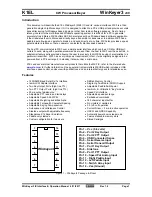
Hardware
18
SLAU747B – October 2017 – Revised January 2019
Copyright © 2017–2019, Texas Instruments Incorporated
MSP432P4111 SimpleLink™ microcontroller LaunchPad™ development kit
(MSP-EXP432P4111)
2.5.1
XDS110-ET USB Power
The most common power-supply scenario is from USB through the XDS110-ET debugger. This provides
5-V power from the USB and also regulates this power rail to 3.3 V for XDS110-ET operation and 3.3 V to
the target side of the LaunchPad. Power from the XDS110-ET is controlled by the isolation block 3V3
jumper, ensure this jumper is connected for power to be provided to the target MCU side.
Under normal operation, the LDO on the XDS110-ET can supply up to 500 mA of current to the target side
including any BoosterPack plug-in modules plugged in. However, when debugging and using the
EnergyTrace technology tool, this current is limited to 75 mA total. Be aware of this current limitation when
using EnergyTrace technology.
2.5.2
BoosterPack Plug-in Module and External Power Supply
Header J6 is present on the board to supply external power directly. It is important to comply with the
device voltage operation specifications when supplying external power. The MSP432P4111 has an
operating range of 1.62 V to 3.7 V. More information can be found in the
MSP432P4x1xI SimpleLink
Mixed-Signal Microcontroller
data sheet.
2.6
Measure MSP432 Current Draw
To measure the current draw of the MSP432P4111, use the 3V3 jumper on the jumper isolation block.
The current measured includes the target device and any current drawn through the BoosterPack
headers.
To measure ultra-low power:
1. Remove the 3V3 jumper in the isolation block, and attach an ammeter across this jumper.
2. Consider the effect that the backchannel UART and any circuitry attached to the MSP432P4111 may
have on current draw. Disconnect these at the isolation block if possible, or at least consider their
current sinking and sourcing capability in the final measurement.
3. Make sure there are no floating input I/Os. These cause unnecessary extra current draw. Every I/O
should either be driven out or, if it is an input, should be pulled or driven to a high or low level.
4. Begin target execution.
5. Measure the current. Keep in mind that if the current levels are fluctuating, it may be difficult to get a
stable measurement. It is easier to measure quiescent states.
For a better look at the power consumed in your application use Ener Technology. Ener
Technology allows the user to see energy consumed as the application progresses. For more details
about Ener technology, see
2.7
Clocking
The MSP-EXP432P4111 provides external clocks in addition to the internal clocks in the device.
•
Q1: 32-kHz crystal (LFXTCLK)
•
Q2: 48-MHz crystal (HFXTCLK)
The 32-kHz crystal allows for lower LPM3 sleep currents and higher precision clock source than the
default internal 32-kHz REFOCLK. Therefore, the presence of the crystal allows the full range of low-
power modes to be used.
The 48-MHz crystal allows the device to run at its maximum operating speed for MCLK and HSMCLK.
The MSP432P4111 device has several internal clocks that can be sourced from many clock sources. Most
peripherals on the device can select which of the internal clocks to use to operate at the desired speed.















































